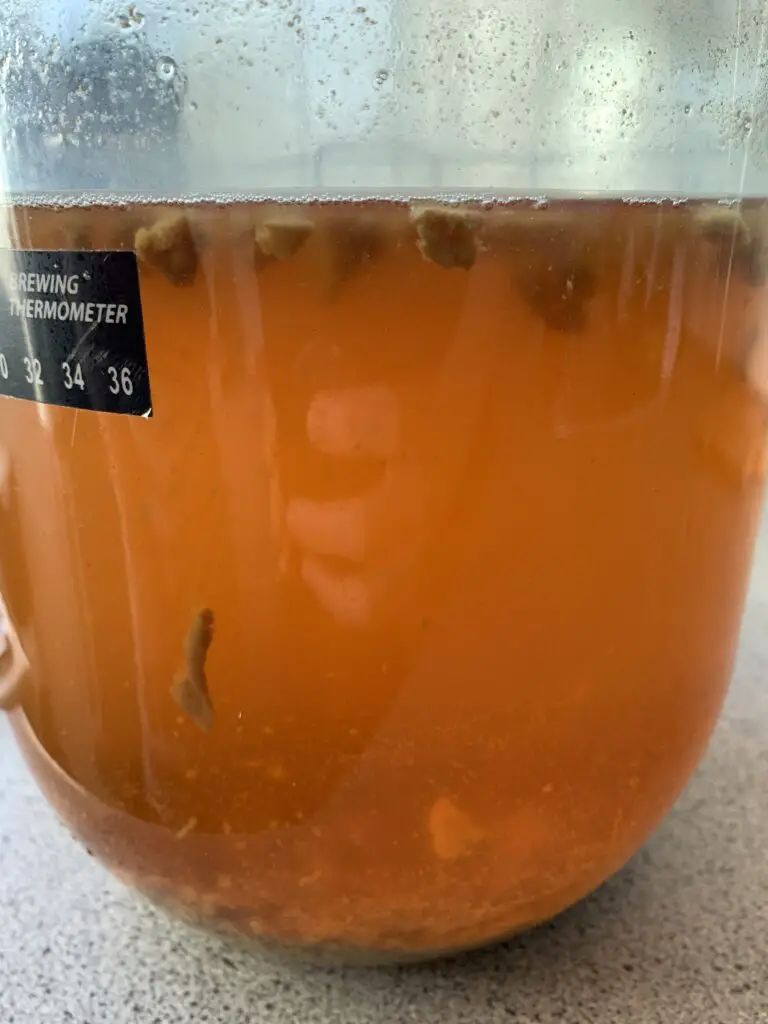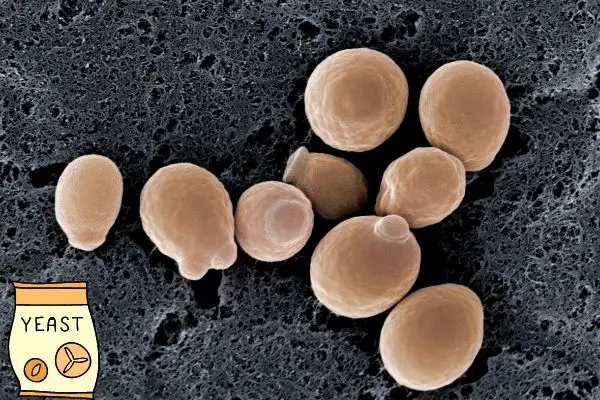Cider, a refreshing alcoholic beverage made from fermented apple juice, has been enjoyed for centuries. While cider is relatively easy to make, it does require the addition of yeast to kickstart the fermentation process.
Adding a lot of yeast to your juice when starting your brewing process can jumpstart the fermentation process and speed up your cider brewing. However, you don’t want too much yeast as it can make the fermentation happen too fast, which may cause foam, higher temperatures and overflow, and excessive yeast early on may lead to off-flavours as the yeast dies off quickly.
Overall, while it can be ok to add a lot of yeast to cider, it may not necessarily be a problem. It is important to use the appropriate amount of yeast and consider adding yeast nutrient for healthy fermentation.
So grab a glass of your favorite cider and let’s get started!
The Effects of Excessive Yeast in Cider
Adding too much yeast to cider can have negative effects on the flavor, aroma, and appearance of your finished product.
Excessive yeast overgrowth can create off-flavors and aromas, including a higher alcohol content than desired, more methanol, or simply too aggressive foaming that causes overflow of your fermentation vessel.
It can also cause the cider to become cloudy in appearance. Controlling yeast levels is essential to improving the quality of your cider.
In deciding how much yeast to use for cider fermentation, take into account key factors like the type of yeast, cider recipe, and fermentation temperature.
Using too much or too little yeast can lead to undesirable consequences, such as off-flavors, stalled fermentation, and overcarbonation.
BUT!
It’s important to remember that most yeast does not come from what you add at the beginning, but from what is formed by cell division during the fermentation process!

For example, if you add 1 gram to a 1 gallon (3.78 Liter) flask and assume a maximum density of yeast of 10^9 cells per ml (requires a good juice with added yeast nutrients!), you will have about 50mg of yeast per ml (assuming a mass of 4.7 × 10-5 micrograms) when the fermentation is at its highest (late log phase in the figure above!).
This gives as a final yeast weight of 0.05g x 3,785.41 millilitres = 189.27 grams of yeast mass at peak fermentation (give and take!)
These are approximate calculations, but you get the point right? No matter if you added 1 or 10 grams to begin with, you will end up with at lest 200 grams (7 oz) per gallon (53 grams per liter) in a well supporting substrate.
The starting amount of added yeast does not influence that number very much! However, the speed to which you get there will…
So don’t worry too much about pitching the right amount, but you might at least save some money by not using too much and at worst you will have to add some more later when you discover the fermentation is stuck.
If you are more interested in the mathematics behind yeast and fermentation speed, take a look at my slightly more nerdy post on whether adding more yeast will speed up fermentation (and how much!).
Excessive yeast in cider can lead to off-flavors and aromas
If you add too much yeast to your cider, you may experience some unpleasant off-flavors and aromas. Excessive yeast can lead to a yeasty taste that overpowers the natural flavors of your cider.
Adding a lot of yeast early on will encourage early breakdown of the yeasts cells to release metabolites, proteins and DNA into the brew that all affect the taste!

This can be especially problematic if you’re using specific yeast strains to enhance the taste or aroma of your cider. Additionally, the byproducts of overzealous yeast can create aromas that range from bready or doughy to sulfuric or rotten egg-like.
Overall, excessive yeast can throw off the delicate balance of flavors and aromas in your cider, so it’s important to be mindful of how much yeast you’re using to avoid potentially negative consequences.
Yeast overgrowth can cause a higher alcohol content than desired
When making cider, it’s important to consider the amount of yeast you use, as too much can lead to unwanted consequences.
One such consequence is a higher alcohol content than desired. Yeast overgrowth can cause fermentation to continue for longer than necessary, resulting in a cider with a higher ABV than intended.
This can make the cider harsh and overly alcoholic, taking away from the desired flavor profile. It’s crucial to control yeast levels in order to achieve the desired taste and alcohol content in your cider.
By monitoring yeast amounts and fermentation time, you can ensure that your cider turns out just right.
Too much yeast can create a cloudy appearance in cider
If you have ever poured yourself a glass of cider and noticed that it was hazy or cloudy, it might be due to too much yeast in the mix. Excessive yeast can cause the cider to become murky and unappealing.

Not only does it affect the appearance, but it can also lead to an off-flavor and aroma. Proper yeast control is essential in producing a high-quality cider. It is crucial to determine the appropriate yeast pitching rates for your cider batch.
Using too much or too little yeast can have consequences like a higher or lower alcohol content than desired. In the end, a balanced amount of yeast will lead to a clear and refreshing glass of cider.
When to Add Yeast to Cider – is timing important?
When it comes to making cider, timing is key in order to achieve the perfect balance of flavors and aromas. When deciding when to add yeast to your cider, it’s important to consider the temperature and acidity of your juice.
Cider yeasts thrive at temperatures between 60-75°F, so make sure to keep your juice within this range before adding yeast.
Additionally, it’s important to ensure your juice has a proper level of acidity to promote healthy yeast growth. Once your juice is at the right temperature and acidity level, it’s time to add your chosen yeast strain.
Be mindful of the amount you add, as too much yeast can lead to a higher alcohol content and off-flavors.
Ultimately, the key to successful cider fermentation is balance – a proper amount of yeast added at the right time can lead to a delicious and well-rounded finished product.
Remedying Sick Cider with Proper Acidity and Adding extra Active Yeast.
If your cider is not tasting right or has stopped fermenting, it may be “sick” due to an imbalance of acidity or because too much metabisulfite has been added and the yeast has been rendered inactive.
But fear not – by adding the right amount of extra active yeast and adjusting acidity levels, you can remedy your cider and bring it back to life.
First, test the acidity of your cider using a pH-meter or acid test strips, and adjust as needed with sodium bicarbonate (baking soda) or calcium. The pH should not be lower than 3, so add alkalinising agent till it reaches a pH reading above 3.
Then, add a small amount of active yeast to jump-start fermentation and ensure a clean, consistent flavor profile.
If the problem is too much sulfite added, “air out” your cider by pouring it back and fourth between two vessels. This is best done when the cider is stuck at the very beginning as oxygen exposure is not great for a fermentation at the later stages.
With the proper care and attention, even “sick” cider can be salvaged and transformed into a delicious, refreshing drink to enjoy.
Controlling yeast levels can improve the overall quality of your cider.
Controlling yeast levels in your cider can significantly improve its overall quality. As previously mentioned, excessive yeast can lead to off-flavors and aromas, higher alcohol content than desired, and a cloudy appearance.

On the other hand, using too little yeast can result in incomplete fermentation and a lack of desired flavors. By carefully controlling the amount of yeast used in your cider, you can achieve a balance that enhances the natural flavors of your fruit while still achieving a desirable alcohol content.
Additionally, controlling yeast levels can help avoid issues with spoilage and other cider-making pitfalls. So, don’t underestimate the importance of proper yeast control when producing high-quality cider that is both delicious and consistent.
So, How Much Yeast Should I Use for Cider?
The ideal amount of yeast depends on the volume of cider you are producing, the desired alcohol content, and the yeast strain you are using.
Generally, 1 gram of yeast per gallon of cider is sufficient. However, for a drier, higher-alcohol or hard-to-ferment cider, 2-3 grams per gallon may be ok.
It’s important to remember that most yeast does not come from what you add at the beginning, but from what is formed by cell division during the fermentation process!

Finding the right yeast pitching rate will improve the overall quality of your cider. To ensure a successful fermentation process, add the yeast when the cider is at room temperature and attach the stopper and airlock.
Remember, when it comes to yeast in cider production, moderation is key.
Factors to consider when determining yeast pitching rates
When determining the appropriate amount of yeast to pitch for your cider, there are several factors to consider. As mentioned earlier, too much yeast can lead to off-flavors, higher alcohol content, and a cloudy appearance.
On the other hand, too little yeast can result in a sluggish fermentation process or even a stuck fermentation.
The volume of your cider, the specific gravity, and the desired alcohol content should all be taken into account when determining your yeast pitching rate.
It is also important to note that different types of yeast can have varying effects on the taste and aroma of your cider.
By carefully considering these factors, you can ensure the optimal yeast pitching rate for the best quality cider.
Possible consequences of using too much or too little yeast in cider production
Using too much or too little yeast in cider production can have negative consequences on the overall quality of your cider. Overusing yeast can result in off-flavors and aromas, as well as a higher alcohol content than desired.
This can also cause a cloudy appearance in your cider. On the other hand, using too little yeast can lead to sluggish fermentation and potentially unhealthy levels of bacteria growth.
Determining the appropriate amount of yeast to use depends on several factors, including the desired alcohol content, temperature, and sugar levels of the cider.
By properly controlling yeast levels, you can improve the overall quality of your cider and ensure a successful fermentation process.
References
- https://journals.plos.org/plosone/article?id=10.1371/journal.pone.0188388
- https://www.homebrewtalk.com/threads/fellow-cider-makers-how-much-yeast-is-too-much.483507/
- https://www.reddit.com/r/Homebrewing/comments/j00v0o/added_too_much_yeast_to_my_cider_did_i_ruin_it/
- https://www.quora.com/Will-adding-more-sugar-or-yeast-to-my-homemade-cider-give-it-a-higher-alcohol-content-or-just-ruin-it
- https://tarbarrel.com.au/what-happens-if-you-add-too-much-yeast-to-your-brew/
- https://www.coalitionbrewing.com/can-i-use-beer-yeast-for-cider/




